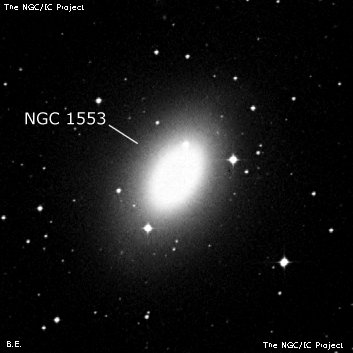
James Dunlop discovered NGC 1553 = D 331 on 5 Nov 1826 and described "a rather bright nebula about 1' diameter, very faint at the margin, gradually bright to the centre: a small star north, and another south, both involved in the margin of the nebula. A group of very small stars north." Dunlop made a 1 hr copying error in his RA (verified by Glen Cozens after examining Dunlop's original observations), and his corrected position is only 10' S of this galaxy, a typical error. Wolfgang Steinicke equates D 331 = NGC 1549, but that seems less likely, as Dunlop's description of two stars involved and a group of stars to the north (near NGC 1549) applies to NGC 1553. But it is surprising that Dunlop apparently missed NGC 1549. On his first sweep (5 Dec 1834), John Herschel recorded "vB, R, gmbM, 60", between three stars."
300/350mm - 13.1" (2/19/04 - Costa Rica): very bright, oval, elongated 5:2 NNW-SSE, 2.25'x1.0', very bright core, fairly high surface brightness halo. With averted vision the halo increases to nearly 3' in length. A mag 12.5 star is at the north edge [1.0' from center], a mag 12.5 mag star is off the SSE edge [1.7' from center] and a mag 12 star is 1.8' WNW of center. Forms a bright pair with NGC 1549 12' NNW in the center of the Dorado Group. IC 2058 lies 17' SE.
Notes by Steve Gottlieb